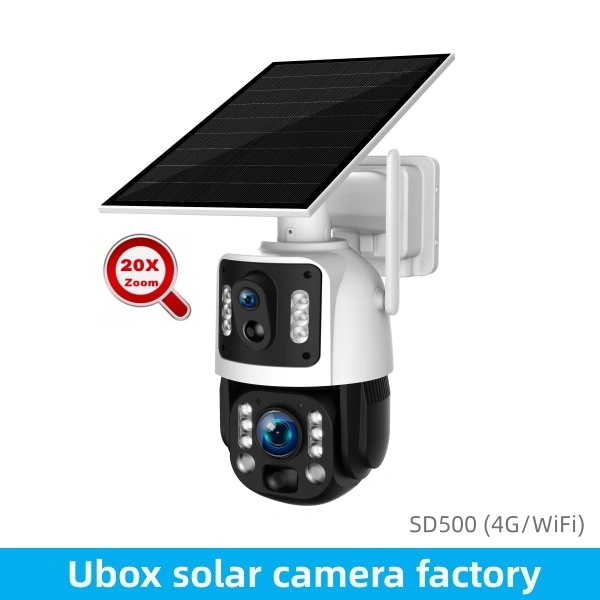Solar Security Cameras vs. Traditional Surveillance: Why Make the Switch?
For decades, traditional wired surveillance systems were the only option for security. However, business owners, wholesalers, and installers are all too familiar with their limitations: exorbitant installation costs involving trenching and cabling, dependence on a stable power grid, and an almost complete inability to secure remote or temporary locations effectively. The recurring expenses and inflexibility represent significant pain points for any modern security project.
As an engineer with over 13 years of experience designing and manufacturing security solutions, I’ve witnessed a fundamental shift in the industry. The future isn’t about adding more wires; it’s about intelligently removing them. Solar security cameras have emerged not just as an alternative, but as a superior solution for a vast range of applications, offering unparalleled flexibility, cost-efficiency, and reliability where traditional systems fail.
This article will break down the core differences between these two technologies. We will move beyond marketing buzzwords to explore the engineering principles, practical applications, and tangible business benefits that make solar-powered surveillance the intelligent choice for 4G operators, brand owners, and security professionals worldwide.
How the Technology Fundamentally Differs
To understand why solar cameras excel, we must first look at their core design philosophy. Unlike traditional systems that are tethered to infrastructure, solar cameras are engineered for complete autonomy. Each unit is a self-contained ecosystem, designed for maximum efficiency and resilience in off-grid environments.
A solar security camera integrates several key components: a high-efficiency photovoltaic (PV) solar panel, a high-capacity rechargeable battery pack, and an ultra-low-power camera module with either 4G LTE or Wi-Fi connectivity. The entire system is governed by a sophisticated Battery Management System (BMS), a critical piece of technology that optimizes charging, prevents over-discharge, and ensures the battery’s longevity and safety. You can learn more about why BMS is the key technology for protecting your investment.
In stark contrast, a traditional CCTV system consists of cameras, a central recording unit (DVR/NVR), and an extensive network of cables for both power and data transmission. Its functionality is entirely dependent on a constant power supply and a stable, wired internet connection. Any failure in this chain—a power outage, a cut cable, or a faulty router—can render the entire system useless.
Core Comparison: Solar vs. Traditional Security Systems
For B2B clients like distributors, installers, and project managers, the decision often comes down to a direct comparison of capabilities and total cost of ownership. The following table provides a clear, at-a-glance analysis of the key differences.
| Feature | Solar Security Camera | Traditional Wired System |
|---|---|---|
| Installation | Simple, fast (hours). No wiring, trenching, or electricians needed. Mount and activate. | Complex, slow (days/weeks). Requires extensive cabling, trenching, conduits, and professional electricians. |
| Power Source | Renewable solar energy with battery backup. Immune to grid power outages. | Reliant on the main power grid. Vulnerable to blackouts without a costly UPS/generator. |
| Connectivity | 4G LTE or long-range Wi-Fi. Completely wireless and independent of local networks. | Requires physical Ethernet cables run to a router or NVR. Limited by cable length. |
| Location Flexibility | Virtually unlimited. Ideal for remote sites, construction areas, farms, and temporary events. | Strictly limited to locations with accessible power and network infrastructure. |
| Scalability | Extremely high. Add new cameras one at a time without impacting the existing system. | Difficult and expensive. Adding cameras may require new cable runs and recorder upgrades. |
| Total Cost of Ownership | Lower. Higher upfront hardware cost is offset by zero installation, trenching, or electricity costs. | Higher. Lower hardware cost is dwarfed by massive installation labor, material, and ongoing electricity costs. |
Case Study: Securing a Remote Construction Site
Problem: A large construction firm was experiencing significant material theft from a new development site located miles from the nearest power grid. The estimated weekly losses were over $5,000. Quotes for a traditional wired system were astronomical due to the need for trenching over half a mile to lay power and data cables, with a project timeline of four weeks.
Solution: The firm partnered with us to deploy a network of five UBOXCAM 4G solar security cameras. Our team helped them select strategic locations covering entry points, material storage areas, and heavy machinery. The entire system was installed and operational by two technicians in less than a day, with no ground disturbance or external contractors required.
Result: The impact was immediate. With 24/7 remote monitoring and motion-activated alerts sent directly to the site manager’s phone, the firm was able to deter intruders and provide clear evidence to law enforcement. Within the first month, material theft was reduced by over 90%. The total cost of the solar camera system was recouped in less than two months from the savings alone. This demonstrates why 4G solar cameras are the ultimate solution for construction sites.
Common Questions & Expert Solutions
As a manufacturer, we frequently address valid concerns from B2B clients evaluating solar technology for the first time. Here are answers to the most common questions.
- What happens during long periods of cloudy weather?
This is a critical engineering consideration. Our cameras are designed with a power budget that accounts for inclement weather. This is achieved through a combination of highly efficient solar panels that generate power even in low light, large-capacity batteries that can store several days’ worth of energy, and intelligent, low-power sleep modes where the camera only fully activates when its PIR sensor or AI algorithm detects a relevant event. - Is 4G cellular data reliable and secure for surveillance?
Absolutely. Modern 4G LTE networks offer robust, high-speed connectivity that is often more stable than residential Wi-Fi. For security applications, data is encrypted during transmission. The key advantage of a 4G security camera is its complete independence from local networks, which can be easily compromised or fail. It is the go-to solution for critical infrastructure and high-value remote assets. - How much maintenance do solar security cameras require?
Maintenance is minimal compared to traditional systems. The primary task is to periodically clean the solar panel to ensure maximum light absorption, especially in dusty environments. Most other health checks, such as battery status and connectivity strength, can be monitored remotely through software. There are no recorders to maintain, no complex wiring to troubleshoot, and no hard drives to replace.
A Practical Checklist for Choosing Your Solar Camera Solution
For wholesalers, brand owners, and installers, guiding your clients to the right product is key. Use this checklist to ensure you’re specifying a solution that meets the project’s real-world demands.
- Assess the Environment: How many hours of direct sunlight will the location receive per day? Check the cellular signal strength (for 4G models) on-site using a standard smartphone.
- Define the Mission: What is the primary surveillance goal? Is it general observation, identifying faces, or reading license plates? This determines the required camera resolution and lens type.
- Calculate Power Needs: Will the camera be recording continuously or only on motion? High-activity areas require larger battery and solar panel configurations. Our engineers can help you model this usage to guarantee year-round operation.
- Evaluate Night Vision: For nighttime surveillance, determine if standard infrared (IR) black-and-white vision is sufficient, or if a Smart Dual-Light system (providing full-color imaging when an event is triggered) is needed for better identification.
- Plan Your Data: For 4G cameras, estimate the data consumption based on streaming and recording quality. We recommend flexible data plans from reputable carriers that are designed for IoT devices.
By following these steps, you can confidently deploy powerful and reliable wireless outdoor security cameras that deliver exceptional value and performance. If you need assistance in designing a system for a large-scale project, our team is ready to provide expert consultation.
Key Takeaways: The Clear Advantages of Solar
The transition from traditional to solar-powered surveillance is driven by clear, undeniable benefits that directly address the core challenges of modern security deployment.
- Unmatched Deployment Speed: Install a complete security system in hours, not weeks.
- Drastic Cost Reduction: Eliminate costs associated with labor, trenching, cabling, and electricity.
- Total Location Freedom: Secure assets anywhere with a sky and a cellular signal.
- Superior Reliability: Operate seamlessly through power outages that would disable wired systems.
- Effortless Scalability: Expand your security network on-demand without infrastructure overhauls.
For any business looking to secure property, monitor remote operations, or offer innovative security solutions to their customers, solar security cameras are no longer the future—they are the new standard. Ready to explore how our customizable, factory-direct solar camera solutions can enhance your business? Contact UBOXCAM today to discuss your project with our engineering team.

